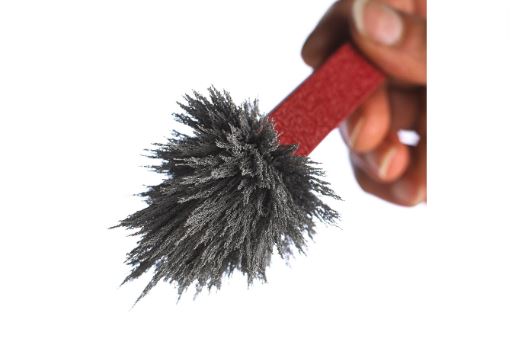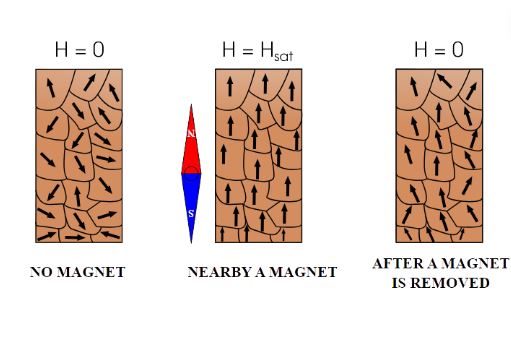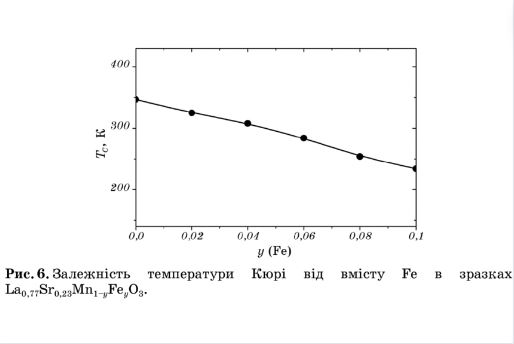The magnetic properties of iron have appealed to scientists for ages. Exploring its magnetic properties is extremely important both in physics and engineering.
Is Iron Magnetic?
Yes, iron is a magnetic material. Iron is unique in that it possesses ferromagnetic trait which makes it a versatile component used in products such as electromagnets, transformers, and magnetic storage devices.

Factors Contributing to Iron Magnetism
Let me take you through some factors contributing to iron’s magnetic behavior:
- Atomic Structure: Iron atoms possess a crystalline structure that makes them favorably react to a magnetic field, and make the iron have stronger magnetic properties.
- Spin Alignment: Iron atoms have unpaired electrons: each of the atoms has its magnetic moment. When these magnetic moments are arranged in the same directions, then the material is magnetized.
- Domain Alignment: The domains of magnetic moments of the bulk iron row contain the atoms orderly aligned.
- Curie Temperature: The Curie temperature of iron is about770 °C (1,418 °F) or 1,043 Kelvin. Control of the temperature and the recognition of it, however, is essential for the application of iron magnets.
- Impurities and Alloying Elements: The presence of impurities or alloy elements can be strong enough to either impede or reinforce the magnetism of iron and in fact have an effect on the magnetic capacity depending on the purity of the consumable material.
Iron vs Ferromagnetism
Iron is a ferromagnetic material that has the property to show a strong magnetic attraction when it comes to magnetic field exposure.
The ferromagnetic property involves the orientation of atomic magnetic moments within the material. This is especially true in the case of unpaired electrons in the valence auto-arrangement.
When these moments happen to be in the same direction, it is the position that results in the material becoming magnetic, specifically when the overall moment is created.
The particular characteristic that distinguishes iron’s ferromagnetism from other types of magnetism is its capability to hold magnetization when the external magnetic field has been eliminated.
This effect, known as hysteresis, is crucial as it is used in applications like electromagnets, transformers, and magnetic storage devices.

Magnetic Properties of Iron Alloys
Let’s discuss the magnetic properties of each of iron alloys:
Carbon Steel:
- Carbon steels, unlike the rest, mostly exist as a mixture of iron and carbon, which has a variable 0.05% to 2.0% range of carbon content.
- The process of cold working and heat treatment make carbon steels’ magnetic properties quite strong which are usually ferromagnetic.
Alloy Steel:
- Alloy steels are made by introducing additional alloying elements such as chromium, nickel, molybdenum, or vanadium in different composition ratios.
- The magnetic properties of the alloy steels may vary according to the particular alloying elements and their concentration.
- Most of the alloy steels are ferromagnetic and they comprise mainly iron, nickel, and cobalt metals.
Stainless Steel:
- Iron, chromium, and sometimes nickel, mangannese, among other varieties of alloying elements are used to make Stainless steel.
- Most stainless steels exhibit paramagnetic feature. This implies that they are weakly attracted to the magnetic field, but if the field is removed, they are no longer magnetized.Stainless steel magnetism is limited to austenitic type which is inherently non-magnetic.
Tool Steels:
- The tool steels are high-alloy and high-carbon steels, which are meant for shaping and cutting materials.
- Just like carbon and alloy steels, most tool steels are ferromagnetic because of their high iron content and mostly have magnetic alloy elements.
Cast Iron:
- Cast iron is less common but refers here to the group of iron-carbon alloys having more than 2 % content of carbon as well as silicon and other alloying elements.
- One of the advantages possessed by cast iron is the fact that its composition and structure can be designed in such a way as to make it exhibit ferromagnetic, paramagnetic, or even antiferromagnetic behavior.
Maraging Steels:
- Maraging steels are a category of high-performance, low-content alloy steels that undergo a unique transformation aging to get their properties.
- Usually the maraging steels package iron, nickel, cobalt, and other elements in their composition.
- Maraging steels have magnetic properties that can vary from each other but in most cases, they show ferromagnetic behavior due to their iron and nickel content.
Iron Curie Temperature
Iron’s Curie temperature is a positive magnetic number, approximately 770 ° C (or 1,418 ° F) or 1043 K. Here the behavior of iron shifts from exhibiting ferromagnetism to paramagnetism.
In particular, below the Curie temperature, the iron atoms show a ferromagnetic nature, by which their atomic magnetic moments align, leading to their magnetization.
But, with temperature growing above this limit, iron will tend to stop being ferromagnetic, showing the paramagnetic characteristic instead.
It is important to have a Curie temperature understanding whenever it comes to the field of iron-based materials which can be used for various applications. This includes magnetic storage devices, electromagnets, and magnetic sensors, where control over the magnetic behavior is vital for functionality.

Magnetic Permeability of Iron
The magnetic permeability of iron is relatively high, uniformly around 1000 to 5000, so it can be used to attract magnetic flux.
Since it creates stronger magnetic fields, the magnetic nature of iron renders it ideal for electric motors, transformers, and electromagnets, all of which promote efficiency.
Having a knowledge of and control over iron permeability might serve a major part in the design of electromagnetic devices.
Magnetize Iron to Make Permanent Magnets
Follow the steps below to magnetize iron and create a permanent magnet:
- Select the appropriate Iron Material: In order to achieve the best possible magnetism, choose iron with low levels of impurities and as high a purity as possible.
- Expose to a Strong Magnetic Field: In order to create the magnetic forces, a strong magnetic field will need to be exposed to the iron, which can be generated using a permanent magnet or by using an electromagnet.
- Align Magnetic Domains: A strong enough magnetic field, can align the magnetic domains in the iron material in the same direction, these domains are arranged randomly as standard in materials. This will increase the material’s magnetic moment.
- Keep Magnetization: To keep the magnetization, be sure to very carefully take away the iron from within the magnetic field so that it remains inside. Even when the outside magnetic field is eliminated, magnetic fields are arranged in this manner.
- Heat Treatment (Optional): Following the procedure of magnetization, special sorts of iron might call for you to heat them. In this case, the procedure will lead to even more specific magnetic features in the material is known as annealing.
- Testing: Make sure to check the iron material magnetization by using a compass or magnetic field detector to detect if it has become a permanent magnet.
Factors Affecting Magnetic Properties of Iron
Below are various factors influencing the magnetic properties of iron:
- Crystal Structure: Crystal shapes of iron are the prominent players of iron’s magnetic nature. For instance, in the bcc structure (body-centered cubic) iron can be found with ferromagnetic properties, while in the fcc structure (face-centered cubic) it behaves as a paramagnetic substance.
- Temperature: With a rise in temperature, thermal energy makes magnetic moments alignment to decrease, thus causing the loss of magnetization in the material. At the critical temperature (770°C for pure iron), iron no longer exists in the ferromagnetic state and becomes a paramagnetic material.
- Alloying Elements: The addition of foreign elements to the fabric of iron enhances the magnetic properties of iron family alloys. For example, if you add nickel, cobalt, or manganese, the ferromagnetism will be enhanced, while if you add aluminum or silicon, the magnetic susceptibility will be reduced.
- Mechanical Stress: Mechanical stress can modify the alignment of the magnetic domain in iron, thus resulting in a change in the magnetic properties. For instance, the strain can yield a new crystal form which also induces magnetization modifications.
- Grain Size: The sizes of iron grains can affect the magnetic behaviors. Much finer grains have the probability of possessing higher magnetic performances. This is because the atom alignment features are more defined due to the increased domain wall density.
- Magnetic Field: The magnetization of iron can be temporarily modified by external magnetic fields. Iron is magnetized using a magnet field, which connects its magnetic domains with an external one. Nevertheless, such magnetization may be transient or permanent, depending on the factors like the type of material, and the technique of manufacturing.
Applications of Iron Due to Magnetic Properties
- Electromagnets: When electric current flows, generates magnetic fields, which are used in speakers, MRI, and magnetic levitation trains.
- Transformers: Transmission of electrical energy among circuits through electromagnetic induction thus, crucial for electric power transmission and voltage level control.
- Electric Motors: Turn the electrical power into kinetic energy making it possible to operate diverse devices from home appliances to machines used in production.
- Generators: Turning mechanical energy into electricity is the basis of how hydroelectric power generators work and how renewable energy sources output electricity.
- Magnetic storage tools: Utilize magnetism so as to store information, like tapes, hard drives, and floppy disks.
To summarize, the ability of iron to become magnetized, due to ferromagnetic properties, makes it crucial in many technologies, among others electronics and storage media, changing the way industries are built as well as science develops.




